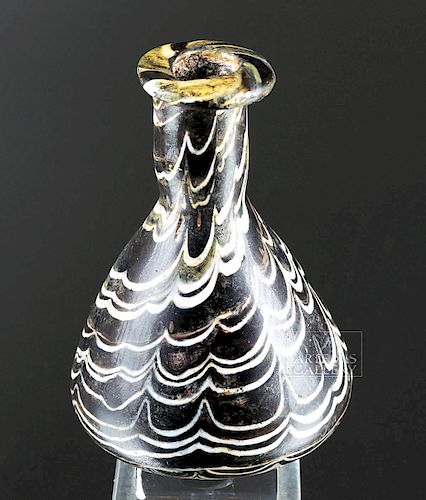Greek Hellenistic Glass Flask w/ White Banding
Lot 37a
About Seller
Artemis Fine Arts
686 S Taylor Ave, Ste 106
Louisville, CO 80027
United States
Selling antiquities, ancient and ethnographic art online since 1993, Artemis Gallery specializes in Classical Antiquities (Egyptian, Greek, Roman, Near Eastern), Asian, Pre-Columbian, African / Tribal / Oceanographic art. Our extensive inventory includes pottery, stone, metal, wood, glass and textil...Read more
Estimate:
$6,500 - $9,750
Absentee vs Live bid
Two ways to bid:
- Leave a max absentee bid and the platform will bid on your behalf up to your maximum bid during the live auction.
- Bid live during the auction and your bids will be submitted real-time to the auctioneer.
Bid Increments
| Price | Bid Increment |
|---|---|
| $0 | $25 |
| $300 | $50 |
| $1,000 | $100 |
| $2,000 | $250 |
| $5,000 | $500 |
| $10,000 | $1,000 |
| $20,000 | $2,500 |
| $50,000 | $5,000 |
| $100,000 | $10,000 |
| $200,000 | $20,000 |
About Auction
By Artemis Fine Arts
Jun 20, 2019
Set Reminder
2019-06-20 10:00:00
2019-06-20 10:00:00
America/New_York
Bidsquare
Bidsquare : Ancient / Ethnographic From Around the World
https://www.bidsquare.com/auctions/artemis-gallery/ancient-ethnographic-from-around-the-world-4217
Around the world & back in time - be amazed at the treasures you will find. Antiquities from Egypt, Greece, Italy and the Near East, Asian, Pre-Columbian, African / Tribal / Oceanic, Native American, Spanish Colonial, Russian Icons, Fine Art, much more! All categories, all price ranges.. all legal Artemis Fine Arts info@artemisgallery.com
Around the world & back in time - be amazed at the treasures you will find. Antiquities from Egypt, Greece, Italy and the Near East, Asian, Pre-Columbian, African / Tribal / Oceanic, Native American, Spanish Colonial, Russian Icons, Fine Art, much more! All categories, all price ranges.. all legal Artemis Fine Arts info@artemisgallery.com
- Lot Description
Ancient Greece, Hellenistic Period, ca. 1st century BCE. A stunning mosaic glass flask of a classic piriform body rising to a tubular neck and a flattened disk rim, all on a flat base - the surface mesmerizing with its rich, dark aubergine/brown (presenting as nearly black) and white color scheme (with the occasional overlapping to form creamy beige and sienna brown hues) - the white bands forming wave patterns across the exterior walls and swirls on the base and rim. Examples like this were created to replicate the natural banded stones such as sardonyx and agate found in nature. Size: 3" in diameter at the widest point x 4.25" H (7.6 cm x 10.8 cm)
A similar example sold at Christie's New York for $10,000 - June 8, 2012 - Lot 130. Their description aptly quotes Wight (Molten Color, Glassmaking in Antiquity, p. 42). A Hellenistic innovation "was to create mosaic glass objects that not only used cut segments of a glass cane but also were patterned with longer cane pieces that were then molded into vessel shapes … While many of the ribbon glass vessels are extremely colorful, glassmakers continued to try to replicate nature by combining colors and patterns that imitated naturally banded stone such as agate and sardonyx."
Provenance: private East Coast, USA collection; ex-Martin Wunsch collection, New York, USA, acquired in the 1980s
All items legal to buy/sell under U.S. Statute covering cultural patrimony Code 2600, CHAPTER 14, and are guaranteed to be as described or your money back.
A Certificate of Authenticity will accompany all winning bids.
We ship worldwide and handle all shipping in-house for your convenience.
#143488Minor surface wear expected with age. Otherwise intact and superb.Condition
- Shipping Info
-
All shipping is handled in-house for your convenience. Your invoice from Artemis Gallery will include shipping calculation instructions. If in doubt, please inquire BEFORE bidding for estimated shipping costs for individual items.
-
- Buyer's Premium



 EUR
EUR CAD
CAD AUD
AUD GBP
GBP MXN
MXN HKD
HKD CNY
CNY MYR
MYR SEK
SEK SGD
SGD CHF
CHF THB
THB
















